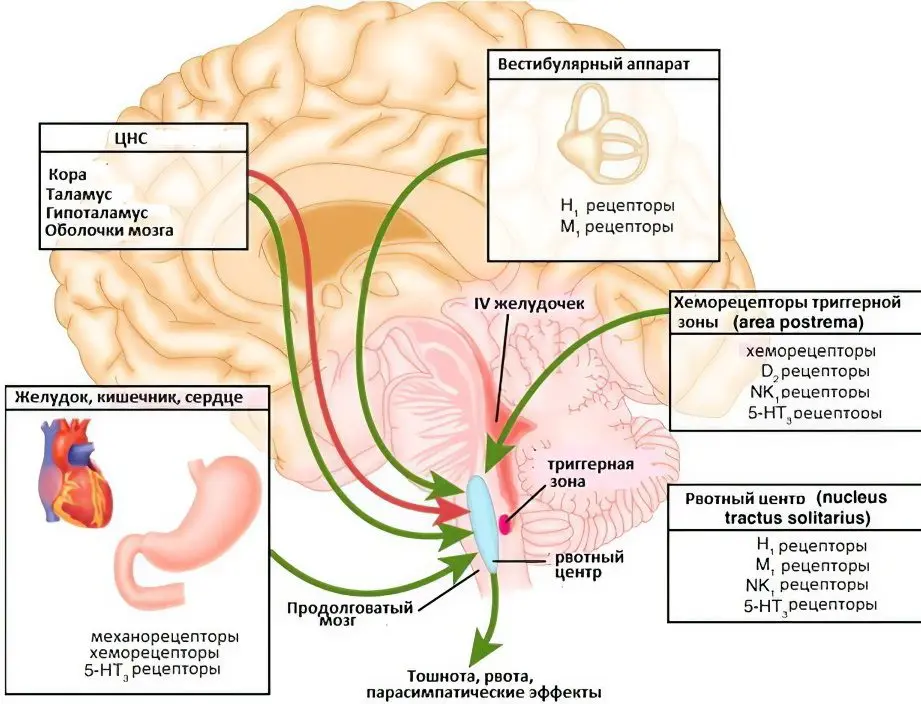Contents
Nausea is a symptom of various diseases. It is expressed in an unpleasant sensation, which is concentrated in the epigastric region (upper abdomen). Discomfort often extends to the esophagus and the oral cavity.
The reasons that can provoke a feeling of nausea can be very diverse. However, all of them in one way or another affect the celiac and vagus nerve. These large nerves, with the help of impulses, transmit a signal to the brain, where the vomiting center is located. Therefore, the person feels nauseous. If the impulses are intense, then he opens vomiting.
Often, along with nausea, a person notes increased salivation, increased heart rate, and weakness. His blood pressure may drop, his skin becomes pale, and his extremities feel cold to the touch.

Causes of nausea

Nausea can be provoked by both external factors and various diseases. If she haunts a person for several days and she is accompanied by other pathological symptoms, you should definitely consult a doctor for advice.
The following reasons can provoke nausea:
Cholecystitis. With this disease, the gallbladder becomes inflamed, which leads to nausea. Sometimes it is provoked by the stones present in the body. An unpleasant feeling develops most often during meals. Other symptoms of cholecystitis include bitterness or a metallic taste in the mouth, heartburn, bloating, and pain in the right hypochondrium.
Taking medications. In the instructions for use for various medications, nausea is listed as a side effect. Most often, nausea is caused by iron preparations, antibacterial and anti-inflammatory drugs. Surprisingly, ordinary vitamins can provoke nausea.
Poisoning the body with poor-quality food. This is one of the most common causes that leads to nausea. It develops slowly, about 2 hours after eating a stale product. It usually ends with vomiting and diarrhea. It is possible to increase body temperature up to 38 ° C and above.
Gastritis, in which inflammation of the lining of the stomach occurs. Nausea develops after eating. In addition to it, a person suffers from such symptoms as: heaviness in the epigastric region, a feeling that the stomach seems to be bursting from the inside. To get rid of the nausea that occurs with gastritis, you need to focus on eliminating the underlying pathology, as well as follow a diet. According to the type of gastritis, gastric ulcer occurs, but the symptoms of this disease are of greater intensity.
Migraine. With severe headaches, a person may experience nausea. In addition, he often gets dizzy.
Pyelonephritis. Nausea with inflammation of the kidneys often turns into vomiting. Other signs of kidney inflammation include pain in the lumbar region, as well as severe discomfort during urination.
Traumatic brain injury. Nausea accompanies a concussion, as well as bruises. In such a situation, you should immediately consult a doctor.
Sun or heat stroke will lead to nausea, dizziness, and even loss of consciousness.
Appendicitis. With inflammation of the appendix, the patient experiences severe nausea, which can turn into vomiting. A person is concerned about pain in the abdomen, which are concentrated in its upper part. Then they move to the right side, to the lower abdomen. In parallel, the patient’s body temperature rises.
Myocardial infarction and other heart diseases. In a person with serious pathologies of the heart, nausea quickly turns into vomiting, abdominal pain appears, hiccups may join. In addition, there are difficulties with breathing, the skin becomes pale.
Meningitis is accompanied by nausea, fever, photophobia. A person has a feeling that the back of his head is bursting from the inside.
parasitic infestations. Some parasites can cause nausea. This feeling occurs regardless of the meal.
Motion sickness of a person during a trip in transport. The weaker the vestibular apparatus, the more intense the nausea will be. In such people, nausea can occur even with a sharp change in body position.
Dieting. If the diet is not made correctly, then the body will need nutrients, which contributes to the disruption of all its systems. Malfunctions in the functioning of the digestive system can cause developing nausea.
Intestinal infections. In addition to nausea, such diseases are accompanied by vomiting, abdominal pain, fever, increased weakness, and diarrhea. To prevent dehydration of the body, you need to start treatment as soon as possible.
The feeling of hunger is often accompanied by nausea.
The use of sweets. If a person eats a product containing a large amount of sugar on an empty stomach, this can lead to a feeling of nausea.
Hypertension. With a persistent increase in blood pressure, the patient has a severe headache, he is haunted by dizziness, and the limbs may swell. Nausea bothers a person most of all in the morning hours, but throughout the day it continues to haunt the patient. It only decreases in intensity.
Stroke. If a person develops a stroke, then his consciousness becomes clouded, intense headaches appear in the back of the head. Nausea is always a companion of cerebral hemorrhage.
Pancreatitis. If the pancreas becomes inflamed, this will lead to severe pain in the abdomen and left side, to nausea and vomiting, and increased gas formation. This body is extremely susceptible to low-quality food, alcohol, fatty and fried foods.
Hypothyroidism. When the body lacks thyroid hormones, the person will suffer from nausea on an ongoing basis. In addition, daytime sleepiness will begin to haunt him, his appetite will worsen.
Tumors of the digestive system. Such neoplasms can be both malignant and benign in nature, but each of them will cause a feeling of nausea. Treatment of cancerous tumors involves the passage of a course of chemotherapy. Taking such heavy drugs is always accompanied by nausea and vomiting.
Carrying a child. In this case, nausea will be a symptom of toxicosis. She worries a woman mainly in the morning. Nausea is often the first sign of pregnancy. By the end of the first trimester, this unpleasant feeling recedes.
Menstrual bleeding can be accompanied by nausea, as during this period there is a hormonal surge in the body. Although most often this unpleasant feeling worries a woman in the middle of the cycle. Another cause of nausea during menstruation is the high water content in the body. Other companions of menstruation may be dizziness, increased nervousness, pallor of the skin.
Types of nausea

Nausea, depending on the cause of its occurrence, can be of several types: toxic, reflex, cerebral, vestibular, metabolic.
They talk about toxic nausea when it develops against the background of poisons, poor-quality food, chemicals, etc., entering the body.
Reflex nausea develops with irritation of the vagus nerve receptors, as well as with inflammation of the stomach lining.
If a person has diseases of the heart or blood vessels, intracranial or arterial pressure rises, a brain tumor develops, then they speak of cerebral nausea.
Vestibular nausea is the result of neuroses. It often affects pregnant women and women during menopause.
If a person adheres to a strict diet, suffers from diabetes, has diseases associated with a violation in metabolic processes, then he develops metabolic nausea.
Nausea and other health symptoms

Depending on the cause that provoked the onset of a feeling of nausea, the accompanying symptoms will differ. The doctor, having analyzed them, will be able to make the most correct diagnosis.
Nausea may be accompanied by symptoms such as:
Diarrhea and vomiting.
Strengthening weakness.
Hypersalivation.
Pale skin.
Hyperhidrosis.
Coldness of hands and feet.
Fall or increase in blood pressure.
Sharp darkening in the eyes.
Increased body temperature and chills.
Dizziness.
Increased sleepiness.
Losing weight.
Feeling that the person is suffocating.
Increased heart rate.
Nausea and dizziness

There are many diseases that are accompanied by both nausea and dizziness.
The most frequently encountered of them include:
Diseases of the muscles of the organs of vision.
Osteochondrosis of the cervical spine.
Vestibular neuritis.
Postponed traumatic brain injury.
Childbearing period.
Diseases of the spine that develop against the background of the injury.
Stroke.
Seasickness.
Otitis media with labyrinth involvement.
Therapy with certain drugs.
Migraine.
Fistula labyrinth.
Tumors of the brain.
Diseases affecting the heart and blood vessels.
Transferred stress.
Climax.
Meniere’s disease.
Anemia.
Hypertension and hypotension.
Low level of hemoglobin in the blood.
Intoxication of the body with alcohol-containing liquids.
Elderly age.
Based on the symptoms that this or that disease gives, the doctor will be able to make a preliminary diagnosis. It will be possible to clarify it only after passing a comprehensive examination.
Nausea and weakness

If a person suffers from nausea, which is accompanied by increased weakness and fatigue, and at the same time his general well-being worsens, then the following diseases can be assumed:
Neoplasms with localization in the brain.
High blood pressure.
Stroke. In addition to nausea and increased weakness, a person’s speech is disturbed, coordination of movements suffers. When the first signs of a stroke appear, a person needs emergency medical care.
Inflammation of the pancreas.
Vegeto-vascular dystonia.
Low blood glucose. In severe cases, a person can lose consciousness and even fall into a coma.
neurological diseases. As a rule, with such pathologies, nausea and dizziness go away on their own if a person changes the position of the body. This is one of the signs that makes it possible to suspect a neurological disorder.
Acute intoxication of the body. With an increase in body temperature, weakness will increase.
Hepatitis. When the liver is damaged, the body as a whole suffers. Metabolic products begin to accumulate in it, which disturb a person’s well-being and cause a feeling of nausea.
Other conditions that can cause nausea and weakness include old age and pregnancy. If these symptoms do not go away for a long time, then you need to consult a doctor.
Nausea in the morning
Sometimes a person suffers from nausea in the morning. Most often, a similar situation is observed in hypertension and in the first trimester of pregnancy. High blood pressure is accompanied not only by nausea in the morning, but also by dizziness, flushing of the skin of the face, swelling and increased fatigue.
If nausea worries a pregnant woman, then you can cope with it by eating an apple or a cookie without getting out of bed.
Nausea after eating

A person may feel sick after eating in the following situations:
Inflammation of the gastric mucosa.
Stomach ulcer.
Inflammation of the pancreas.
Inflammation of the gallbladder.
Heart disease.
Eating fatty foods.
Appendicitis.
Renal insufficiency
Eating large amounts of food.
Stress.
parasitic invasion.
Eating stale food.
Nausea after eating develops most often due to diseases of the digestive system. In addition, a person may experience symptoms such as: bloating, pain along the intestines, discomfort in the right or left side. Sometimes nausea develops in a person due to unpleasant odors that he inhales.
Nausea and high body temperature

Pathologies that are simultaneously combined with nausea and high fever:
Gastritis, which develops against the background of poisoning with drugs, acids, alkalis, food.
Rubella. This viral infection is accompanied by fever, nausea and skin rashes.
Salmonellosis. The disease develops when harmful bacteria, salmonella, enter the digestive tract. They cause fever, nausea, diarrhea, vomiting and other symptoms of poisoning.
Measles. This disease is accompanied by an increase in body temperature to high levels, nausea against the background of intoxication of the body, chills and severe weakness.
Meningitis.
Angina. Nausea with angina is a consequence of intoxication of the body with decay products that bacteria secrete. The temperature with the defeat of the tonsils always reaches high levels.
Hepatitis. As a rule, nausea and high body temperature are accompanied by damage to the body by the hepatitis A and hepatitis B viruses. A person suffers from incessant nausea, his skin turns yellow, and episodes of causeless vomiting occur.
Intestinal flu or rotavirus infection is an infection that is manifested by diarrhea, nausea and vomiting, fever, severe weakness.
Bronchitis. With bronchitis, body temperature can remain at a level not exceeding 38 ° C. Nausea develops as a result of poisoning the body with pathogenic bacteria or viruses that have settled in the bronchi.
Scarlet fever. This disease is caused by hemolytic streptococcus. Children are more susceptible to infection. The disease proceeds according to the type of angina, but is accompanied by rashes on the skin, which look like a small punctate rash.
Intestinal dyskinesia. Pathology is accompanied by nausea, pain along the intestines, diarrhea and / or constipation.
Erosion of the esophagus and stomach.
Transferred operations on the organs of the digestive system.
Nausea and diarrhea

If, in addition to nausea, a person’s stool liquefies and becomes more frequent, this will indicate a violation in the functioning of the digestive system.
The following factors can provoke such a situation:
Virus infection.
Bacterial infection.
Inflammation of the pancreas.
Eating foods that have undergone insufficient processing.
Taking certain medications.
Diet errors.
Diarrhea cannot be ignored, as it leads to rapid dehydration of the body. This situation poses a threat to the health of both adults and children. During diarrhea, drink plenty of fluids.
Nausea in a child

A child can feel sick for a variety of reasons.
These include not only disorders in the digestive system, but also such pathologies and conditions as:
High intracranial pressure. In addition to nausea, the child will have a headache.
Eating a large number of foods. If the child has overeaten, then he will have pain in the abdomen and a feeling of fullness in the stomach.
Underdevelopment of the vestibular apparatus. The child may feel sick while traveling in a car or other vehicle. Therefore, it is best to choose those places where it will be less rocked.
Dehydration of the body. Sometimes children feel sick after they have been moving a lot and actively, but they have not consumed enough water. To cope with an unpleasant feeling, the child just needs to be drunk.
Stress. Often children experience nausea at the peak of emotional excitement. That is why it is so important to avoid such situations. If it still happened, then you need to try to calm the child, perform breathing exercises with him.
Allergic reaction of the body. The child may feel sick if he has eaten a food to which he is allergic. A similar situation is observed when undergoing treatment with drugs to which the body has an individual intolerance.
Treatment for nausea

Nausea does not develop on its own, so in order to get rid of it, you need to act on the cause of this unpleasant symptom. Trying to manage nausea on your own is not recommended. It is necessary to seek the advice of a specialist, otherwise serious health complications may develop.
Depending on the situation, you can cope with nausea in the following ways:
If nausea is a consequence of eating too much food, then you need to reduce portions, refuse fatty and spicy foods.
Enterosorbents, for example, enterosgel, smecta, are prescribed for nausea provoked by poisoning. These drugs allow you to quickly remove toxins from the body without disturbing its own microflora.
If a person is motion sick in transport, then you can take special pills, or use a patch with scopolamine. It is glued 6 hours before the upcoming trip.
Coping with psychogenic nausea allows courses of psychotherapy.
Nausea during childbearing is well stopped by eating light foods. They need to be eaten immediately after waking up, before getting out of bed. Alternatively, you can suck on a mint candy. When it is not possible to cope with nausea with the help of food intake, you need to take Meclozin inside, but only after consulting a doctor. The drug is used both in candles and in tablets.
If a person is sick and dizzy, then the following recommendations will help to cope with this problem:
Need to lay down.
It is necessary to provide access of fresh air to the room.
If a person faints, then you need to give him a sniff of cotton wool with ammonia.
When nausea and dizziness are symptoms of low blood pressure, then you need to take a glass of sweet tea or coffee.
With nausea caused by stressful situations, as well as nervous strain, you need to take a sedative drug. It can be valerian, motherwort tincture, Novo-passit, Seduxen, etc.
If it is not possible to cope with the problem using the above methods, then the patient is prescribed Cerucal or Metoclopramide.
A doctor should prescribe medications to relieve nausea.
He may recommend to the patient the use of such means as:
Domperidone, Aminazine, Etaperazine are neuroleptic drugs.
Diphenhydramine, Diazolin, Pipolfen – allergy drugs.
Cerucal and Alizaprid are drugs that block dopamine receptors.
Aeron, Motilium, Metacin.
To get rid of nausea, you need to influence the cause of its occurrence.
Video: the program “about the most important thing” – nausea: causes, symptoms, possible foci of the disease and treatment:









